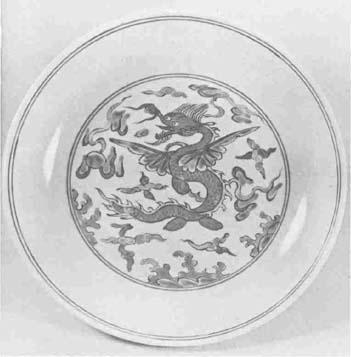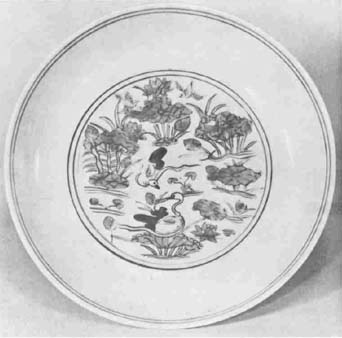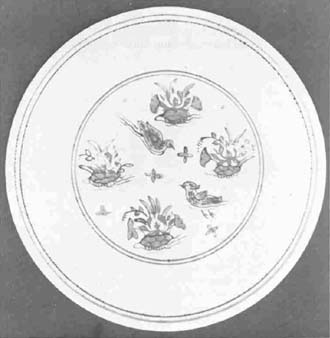
Bulletin 28, 1976
Home
Français
Introduction
History
Annual Index
Author &
Subject
Credits
Contact


![]()

Mandarin
Ducks in Sixteenth-Century Chinese Porcelain: A Wan-li Bowl in the
National Gallery of Canada
by Yutaka Mino and Katherine Tsiang
Pages 1
| 2 | 3
The theme of ducks on a lotus
pond can be seen on a number of enamel-decorated porcelains of
rather controversial date. Our study of the development of this
theme may be able to throw some light on these pieces. The technique
used in painting these pieces is distinct from the tou-ts'ai technique
in that it does not involve the use of underglaze blue outlines, and
is referred to as wu-ts'ai ("five colours"). These
wu-ts'ai examples are painted in red, green, yellow, and turqoise.
Three of the known examples of wu-ts'ai employing
the ducks and lotus pond motif have a four-character dynastic mark Ta
Ming nien tsao ("Made in the great Ming dynasty")
written on the base in overglaze red. One of these, a dish sold at
an auction in London, has, on the inside, a central circle painted
with ducks and lotuses and a moulded lotus pattern around the well.
(9)
The outside is painted with fish and lotuses; the fish have
pointed noses and rounded, fanlike tails. A bowl in the Museum für
Kunst und Gewerbe (Hamburg) is painted in a nearly identical manner.
(10)
A dish in the Percival David Foundation of Chinese Art (London)
has a very similar central lotus pond and ducks with fish and
lotuses painted around the well (fig. 10). (11) This piece has a
Ch'eng-hua reign-mark in underglaze blue on the base. The outside is
painted with stylized lotuses joined by a leafy scroll. A dish in
the collection of Harry Garner is practically identical except that
it has no turquoise in the painting. (12) Instead of a Ch'enghua mark,
however, it has a Ming dynastic mark in red like the London and Hamburg pieces. These four
pieces have been accepted by many as being of the
Ch'eng-hua period, and their excellent quality and
rare design have made it difficult to prove otherwise.
Nevertheless, there are a number of reasons for questioning such an
early attribution. It is known that potters of the latter part of
the Ming dynasty often turned to earlier pieces for inspiration and
freely inscribed their work with the mark of an earlier reign. This
may well be the case for the David dish. As there are no other
examples known to be of the Ch' eng-hua period that are painted in
this style, we must look to other periods for comparison. The fish
with pointed nose and rounded tail depicted on the David dish is a
type frequently represented on fourteenth- and early fifteenth-century
blue-and-white porcelain. They also appear on a
blue-and-white dish with the Chia-ching (1522-1566) reign-mark that
was made as an imitation of one of the Hslian-te period (1426-1435).
(13) The lotus-scroll design around the outside of the
David dish closely resembles that painted in tou-ts'ai on a
group-shaped vase bearing a Chia-ching mark that is in the National
Palace Museum, Taipei. (14)
An examination of other Chia-ching pieces brings out additional
interesting points of comparison. A round, covered jar in the
National Palace Museum (15) and a related, four-sided jar (16) (both
painted in red, green, yellow, and brown enamels) have, around the
flying horses, the same fluttering ribbons as the David dish. A
dish in the Idemitsu Art Gallery, Tokyo (fig. 11), which is
decorated with a winged dragon and pearl in red, green, turquoise,
and yellow enamels, also shows the fluttering ribbons and bears a
cyclical date written in red which may correspond to either the
seventeenth year of the Ch'eng-hua period (1481) or the twentieth
year of the Chia-ching period (1541). (17) Japanese scholars agree on
the latter interpretation, for which there is stylistic backing.
(18)
Furthermore, a porcelain kuei, decorated with similar dragons
and pearls in red, green, and yellow enamels, is known which is
dated the forty-third year of Chia-ching (1564). (19)
A Chia-ching date for the David and related pieces seems likely.
Although wu-ts'ai porcelains bearing Hsüan-te, Ch'eng-hua,
Cheng-te, and Chia-ching reign-marks exist, (20) their close
similarities in style of decoration indicate a proximity in date as
well, and it seems not unreasonable to assign them all to the
sixteenth-century.
This brings us to two dishes decorated with scenes of waterfowl on a
lotus pond and actually bearing the Chia-ching reign-mark. The first
is a wu-ts'ai dish in the Idemitsu Art Gallery with two waterfowl,
may be either ducks or geese, and side (fig. 12). (21) One bird is
swimming down from the centre of the picture toward the other,
seen from the side, below it. The second dish, in the National
Palace Museum, is the most important for our purposes as it is
decorated in exactly the same manner as the Ottawa bowl. (22) The
mandarin ducks and lotuses are outlined in blue and painted with
red, yellow, and green enamels; the ducks on the outside alternate
with clumps of lotuses and aquatic plants (fig. 13) and those on the
inside are in the midst of four clumps (fig. 14). The female in
the centre is shown in three-quarters view swimming diagonally down
toward the drake in the lower right portion of the picture,
similar to the decoration on the wu-ts'ai dish just
mentioned. The clumps of lotuses are placed in a rigidly
symmetrical arrangement. The blue lotus-petal panels around the
foot, though slightly different in appearance, can be seen to be
composed of basically the same lines as those on the Ottawa bowl.
In the light of this last tou-ts'ai dish, the Wan-Ii tou-ts'ai bowls, including the Ottawa piece, are in all likelihood
products of the early part of the reign. These pieces were probably
made for only a short time and for a limited clientele. The fact
that two out of the six known examples with this decoration are in
the former imperial collection is evidence that they were made
especially for court use.
The theme of ducks on a lotus pond was quite commonly used in the
Lung-ch'ing (1567-1572) and Wan-li periods on wu-ts'ai porcelains,
particularly large basins (fig. 15) (23) and vases (fig. 16). (24) These
generally show a more naturalistic and lively treatment of the
subject, incorporating it into a broader scheme which includes other
birds, flowers, and trees. Wu-ts'ai wares became much more
popular than tou-ts'ai in the sixteenth-century. They
exhibit a boldness and exuberance in design and use of colour
which was widely appreciated both in china and abroad. The formal
symmetry and restraint of the Ottawa bowl lend it a more staid and
delicate air which recalls the famous tou-ts' ai wares of the
Ch'eng-hua period. In fact, this piece can be said to represent a
conscious effort to recreate a past style. The veneration of
tradition that is inherent in the theme of marital fidelity is
fittingly echoed in this stylistic archaism.
Next Page | Notes
1
| 2 | 3
Annual Index | Author & Subject | Credits | Contact
This digital collection
was produced under contract to Canada's Digital Collections program,
Industry Canada.
"Digital
Collections Program, Copyright
© National Gallery of
Canada 2001"